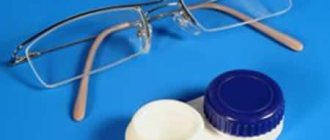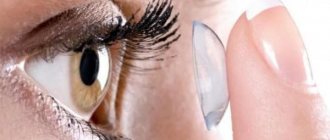What is visual acuity? In Russia and the CIS countries, this value is measured in conventional units and its indicators can be different: 0.1; 1; 2, etc. They range from zero (i.e. complete blindness) to infinity.
It is worth explaining that visual acuity is the ability of the eye to separately see two points located at a certain distance from each other.
In the CIS countries and Russia, it is customary to check this value using various posters (Golovin and Sivtseva in adults and Orlova in children).
With visual acuity equal to one, 10 lines are clearly visible at a distance from the table of 5 m (this is considered normal). If 12 lines are visible, then the level of vision is 2. On the right side of the lines, indicators of this value are written depending on the number of lines that the subject sees at a distance of five meters. That is, if he can distinguish only 1 line, then the indicator is 0.1; if 2 – 0.2, etc.
Tables to check
Special posters are used to carry out diagnostics. They may contain images of various designs, letters, icons or hooks.
- The most popular among Russian ophthalmologists is a poster depicting letters (Sivtsev’s table).
- Sometimes doctors use the Golovin table, which shows rings with ruptures.
- When checking children, ophthalmologists prefer Orlova's poster with different pictures.
Letters or pictures are located on twelve lines, and their size decreases with each line (starting at the top and going down). On the left side of each line, the symbol “D” indicates the distance from which, with good vision, the subject should see all the symbols. For the top line it is 50 meters, and for the bottom line 2.5. On the right side of the lines, the letter “V” indicates visual acuity indicators, which are correct when the subject reads symbols from 5 meters. This indicator is equal to 2 if the subject distinguishes the bottom line and 0.1 if he sees only the first.
Diopters for myopia and a table for diagnosing myopia
Myopia or myopia is a disease in which the visibility of distant objects deteriorates. Up close, a person sees clearly. A decrease in visual acuity is expressed in diopters; for myopia, a minus sign is placed in front of the number. The higher the degree of the disease, the shorter the distance of best vision - from the eye to the object in question.
Why does myopia occur?
The organ of vision has a complex structure. Normally, the eyeball has its own shape, resembling an ellipse, in which the longitudinal and transverse dimensions are related in a certain way.
Thanks to this, light entering through the pupil produces an image on the retina (this is where there are receptors that perceive color and black and white images).
It is processed and transmitted to the brain along the visual tracts.
With myopia, the curvature of the convex part of the eye changes, and the picture of the surrounding world falls on the space in front of the retina, where there are no receptors capable of receiving, reproducing and transmitting it to the brain. Therefore, a person with myopia sees distant objects blurry, as if in a fog - he cannot perceive them.
Causes of myopia:
- congenital characteristics transmitted by inheritance;
- eye injuries;
- heavy strain on the eyes from reading, writing, TV screens and gadgets.
What are the complaints with myopia?
A person is worried about blurred vision of distant objects, decreased color perception, large yellow or white halos around light sources, especially clearly visible in the dark. The numbers on the boards of public transport, inscriptions on billboards and the walls of houses, price tags in stores, and the text of slides at lectures become difficult to distinguish.
You have to squint, strain your eyes, facial and forehead muscles. As a result, frequent headaches and increased blood pressure occur.
Degrees of myopia
To determine treatment tactics and visual loads, myopia is classified according to severity:
- light – up to -3 diopters;
- average – from -3 to -6 diopters;
- high – above -6.25.
A high degree can reach values of -15, -20, -25 diopters.
: “Minus” vision, what does it mean?
Diagnosis of myopia using a table
A simple method helps to identify the disease - determining visual acuity using the Sivtsev table, developed in 1925. For adults, these are 12 lines with black letters of different sizes on a white background. The top one is the largest, the bottom one is the smallest. For children, the letters are replaced with images of animals, toys, plants or torn rings.
According to the norms, the table has standard dimensions, is located on a brightly backlit screen, and is located at a distance of 5 meters from the subject. The bottom edge should be 1.2 m above the floor.
Each line represents 0.1 of visual acuity. If a person sees 10 lines, starting from the top, then his visual acuity is 1.0 (0.1 x 10 = 1.0). If only 5, then 0.5 (0.1 x 5 = 0.5).
With farsightedness, the 11th and 12th lines will be clearly distinguishable.
When the ability of the eyes to distinguish letters is not enough, then glasses are selected. The doctor puts on the frame, closes one eye, and places a glass with diopters in front of the other. In this way, the optimal parameters for each eye are determined.
The patient then looks with both eyes. This is an important point, since with high myopia it can be difficult to look simultaneously with the left and right eyes through glasses with diopters. Objects may become distorted, especially in the periphery. In this case, glasses with smaller values of corrective glasses may be prescribed.
Determination of myopia in children and adolescents
In children under 5–6 years of age, the examination is based on the same principle. The child is seated on a chair, one eye is closed, and visual acuity in the other is checked. Adjust if necessary. Then they look at the second eye. Then they are asked to name what is drawn on the table (fungus, car, bear, bunny, etc.), looking with both eyes.
Related article: Myopia in preschool, school-age children and adolescents
For older children, there is a table with rings in which part of the circle is missing. The subject must name in which direction the gap is directed - left, up, down or right. This is convenient for those who do not know the letters, but can guess or remember the location of the pictures in the table described above.
How to determine vision using a table
Diagnosing myopia using a table helps to quickly and easily identify the presence of pathology. Determination of visual acuity is possible in both adults and children. Knowing how the eye sees, the doctor can prescribe treatment and prescribe glasses. This significantly makes the patient’s life easier and improves its quality.
: How to check visual acuity (Sivtsev table)
In addition to diagnosing the problem, using the table it is convenient to track the dynamics of the condition. For example, is there any improvement after the course of therapy or is there a worsening or progression of myopia. In such cases, the question of performing surgery to correct myopia may be raised.
Source: //ozrenieglaz.ru/bolezni/blizorukost/dioptrii-pri-blizorukosti-tablitsa
Unit converter
Optical power (refractive power) D
- a unit of measurement of the refractive power of an optical system consisting of lenses, convex or concave mirrors. Optical power is calculated using the formula:
D
= 1/ f
where
f
is the focal length of the system. The optical power of lenses with a longer focal length is less.
Optical power is measured in SI units in diopters (D, diopter). Diopter is a non-systemic unit. The corresponding SI unit is the reciprocal meter m⁻¹. For example, a lens having an optical power of 2 diopters can focus parallel rays of light at a distance of ½ meter.
We feel the effect of the above formula when we dive without a mask or swimming goggles - objects under water are blurred because the refractive index of water at 20°C is 1.33. The cornea, which provides about two-thirds of the eye's magnification, has approximately the same refractive index as water. When the cornea is in contact with water, it ceases to magnify the image of surrounding objects, that is, it ceases to be a convex lens. All that remains is the lens, which provides only a third of the total optical power of the eye, or about 20 diopters, and is not capable of providing a sharp image of surrounding objects on the retina. A simple calculation using the above formula shows why this happens: f
= 1/ D
= 1/20 = 0.05 m or 50 mm; at the same time, the diameter of the human eye is approximately 24 mm. As we can see, parallel rays of light entering the eye will be focused far behind the retina. Man is a land creature and the optical system of the human eye is “designed” in such a way that it does not provide normal vision under water without special devices. Sharpness underwater can only be ensured by a mask that provides a layer of air between the eyes and the water.
To measure the refractive power and other optical characteristics of spectacle lenses, dioptrimeters, also called lensmeters, are used - optical instruments consisting of a telescope, a collimator, a holder for the lens being measured and other mechanisms.
I've been wearing glasses for over ten years, so I'll try to tell you how to clean up your regular glasses or sunglasses with or without anti-reflective coatings and oleophobic coatings. By the way, it is much easier to care for glasses with an oleophobic coating than without it!
Many people do things every day that they shouldn’t do: they breathe on their lenses and then wipe them with their sleeve or the edge of their clothing. If this could be done with glass lenses, then plastic will not tolerate this. After a few months, the glasses will be scratched and, to the delight of the optical salon workers, you will come back for new glasses in less than a year.
When I started wearing reading glasses every day 10 years ago, I didn't know how to properly care for them. I have seen advertisements for many eyeglass care products and have even tried a few. But then I realized the best way to care for your glasses without scratching them—they need to be washed! I must say that when I got ready to write about this and began to study the issue, it turned out that the idea is not at all new and many people do this!
Most importantly, never dry your glasses with paper towels. They contain wood particles that will scratch the lenses. Even fabric that is 100% cotton can still be dusty and contain abrasive particles.
You can, of course, use special glasses cleaners, but why spend money if tap water plus a drop of dishwashing liquid and a drop of isopropyl or ethyl alcohol cost next to nothing?
As it turns out, all that is required is to wash the dust off your glasses in warm water, then lightly wipe them with a drop of dishwashing liquid. Rinse with tap water, then with distilled water if the tap water is hard. And finally, dry the glasses with a rubber bulb or compressed gas from a can. After this procedure, the lenses will be clean and scratch-free.
And now in more detail:
Wash your hands to remove oil from your fingers.
Rinse your glasses lenses with warm water to remove dust.
Place a drop of dishwashing liquid on your finger. This liquid is designed to remove grease from dishes. But this is exactly what needs to be done with glasses! Remove fat!
Using a circular motion and using minimal pressure, wash both sides of the lenses with dishwashing liquid. You can also wash the frames, temples, bridge and nose pads with this liquid.
Rinse your glasses with warm water, which should remove all soap. There is no need to rub the lenses with your fingers when rinsing. If tap water is hard, that is, it contains an increased amount of dissolved calcium and magnesium salts, it is advisable to rinse the glasses in distilled water.
After rinsing, shake the glasses thoroughly to remove water. I prefer to do this on my knee.
All that remains is to remove the drops using a rubber bulb or a can of compressed gas to remove dust. If you rinse your glasses with distilled water, they will dry without traces of salts and there is no need to rinse them unless you need them immediately.
Usually, when you order new glasses, they come with a piece of cleaning cloth. Opticians put it in for the sole purpose of making you come to them more often! Any cloth, especially paper towels or napkins, will scratch your glasses lenses because they contain abrasive particles. In addition, they usually do not wipe, but only spread grease and dirt onto the surface of the lenses.
If you are blowing away drops of water with gas from a can, press the trigger slowly so that liquid does not get on the lenses along with the gas. If this does happen, you will have to wash your glasses again. Finally, you can remove any remaining water from the end surfaces of the lenses.
About alcohol. Some people believe that alcohol can damage the anti-reflective coating on lenses or even dull them. Don't know. I always use isopropyl alcohol to remove grease from lenses if they are very dirty. This happens sometimes. I have never noticed any problems with the quality of the coating. As you can see, well-known manufacturers of optical instruments also use isopropyl alcohol in wet wipes to clean lenses and eyeglass lenses.
For those who shoot with SLR cameras, I can say that filters installed on photographic lenses can be washed using the same method. I wash them with dishwashing detergent, then rinse them under the tap, then with distilled water and blow off drops of water with a rubber bulb or gas from a can. Unfortunately, you cannot wash the front lens element in this way.
Author of the article: Anatoly Zolotkov
Eyesight check
We are faced with the need for a vision test every time we go to school or get a new job, undergo a medical examination at the military registration and enlistment office or to obtain a driver's license.
But are we always aware of what exactly is determined in the ophthalmologist’s office and what is meant by a “vision test”? In many cases, an eye test simply involves checking visual acuity, although this is not the only important characteristic of our eyes.
Currently, a large number of sites offer online vision testing. The process looks simple - you need to select a vision test table that matches the diagonal of your monitor and move away 1-2 meters.
However, vision testing in such conditions gives an extremely approximate result and there are several reasons for this: the size of optotypes (letters, geometric figures), the required image contrast, as well as the distance to the table, which must be at least 4 meters (standard in Russia - 5 meters, in foreign countries - 6 meters) to avoid the influence of accommodation on the result obtained.
Another drawback of such tests is that they omit checking such a rather important vision parameter as refraction. Then how can you use this indicator to determine whether you have nearsightedness, farsightedness and/or astigmatism?
We offer you the option of checking basic vision parameters at home, which gives the closest approximation to vision testing in medical institutions. You may find it a little more complicated than on other sites, and it will take a little more time, but the result will be much more accurate.
Before proceeding directly to the vision test, it is necessary to make some clarifications regarding visual acuity (VA) and refraction. Most people confuse these concepts. We will try to explain their meaning as clearly as possible, resorting to a certain simplification and deviating from the formulations accepted in ophthalmology.
Visual acuity
In accordance with professional terminology, visual acuity is the ability of the eye to distinguish between two points with a minimum distance between them. According to the conventionally accepted norm, an eye with 100% vision (V=1.0) is able to distinguish between two distant points with an angular resolution of 1 minute (or 1/60 of a degree).
In a strong simplification, this means that visual acuity is a qualitative indicator of eye vigilance, making it possible to measure how well (clearly) a person sees.
Visual acuity of 1.0 (100%) is accepted as the norm - the so-called unit. It is determined using special tables with optotypes.
In our country, the most common is the Golovin-Sivtsev table (or simply the Sivtsev table).
A person may have visual acuity greater than normal, for example - 1.2 or 1.5, or even 3.0 or more. In the case of problems such as refractive errors (myopia, farsightedness), astigmatism, cataracts, glaucoma, etc., visual acuity drops below normal, for example - 0.8 or 0.4, or 0.05, etc.
There are often attempts to express visual acuity as a percentage. However, it should be borne in mind that simply converting this indicator into a percentage is incorrect.
In such a recalculation, everything is much more complicated, since it is necessary to take into account other parameters that determine the quality of vision. Therefore, although 1.0 is 100% vision, but, for example, 0.2 is not 20, but 49% of the norm.
Similarly, any indicators of visual acuity that differ from one cannot be converted into percentages by ordinary arithmetic.
What is the difference in visual acuity? The main difference is the distance from which people see the same object equally clearly.
For example, a person with visual acuity of 1.0 can read a license plate from approximately 40 meters, provided there is sufficient lighting. The lower the HP, the shorter the distance from which the number will be read.
With a visual acuity of 0.4, this distance will be approximately 16 meters. At a greater distance, numbers and letters will already merge or become simply indistinguishable.
Another example is that a person with visual acuity of 1.0 reads the top line of the test table from a distance of 50 meters, and with a visual acuity of 0.1 - from no further than 5 meters.
Refraction of the eye
The eye is a complex optical system consisting of several refractive media: the cornea, lens, vitreous humor and aqueous humor. Like any optical system, the eye has a focal length (focus). The position of the focal point of the eye relative to the retina is called clinical refraction, or simply refraction of the eye.
Normally, the focus is on the surface of the retina and this condition is called emmetropia (the refraction is zero). With myopia, the back focus of the eye is located in front of the retina, and with farsightedness, it is behind the retina.
Even in the absence of serious vision problems, it is useful to know the refraction of your eyes. This will help predict future deviations from the norm in adulthood and old age (for example, in the case of latent farsightedness).
If visual acuity is less than normal, then perhaps the cause is refractive errors that require correction.
And when the refraction is normal, it is necessary to look for other reasons related to a decrease in the transparency of the optical media of the eye (for example, this could be amblyopia, clouding of the cornea or lens due to cataracts) or problems of a neurological nature.
Refraction is often confused with visual acuity.
But visual acuity is a quantity that does not have a unit of measurement, while refraction is measured in diopters and is indicated using a unit of measurement, for example, 1.0 D (diopter or diopter).
Sometimes in medical reports, prescriptions, etc., units of measurement are omitted (although this is incorrect); in such cases, the fact that we are talking about refraction is indicated by the entries: sph or cyl.
Refraction affects visual acuity - the greater the deviation of refraction from the norm, the more visual acuity decreases, although there is no direct relationship. That is, it is impossible to calculate how much visual acuity will decrease if the refraction deviates by a certain number of diopters. There is no feedback either - visual acuity does not affect refraction.
Determination of visual acuity using the Sivtsev table
First of all, you need to make a test table. Download the file with Sivtsev’s table and print it on a laser printer.
It is important to take into account the following requirements: • the paper must be white, matte, without shades of yellow; • when printing PDF files, Page Scaling must be turned off; • paper size when printing = A4 (not Letter), orientation - Landscape.
We glue three sheets together and attach the resulting table to the wall using tape or pins. Depending on whether you will be checking your vision standing or sitting, the height of the table is selected - the 10th line should be at eye level.
The table must be illuminated with one incandescent lamp or two fluorescent lamps, so that the illumination is 700 lux (40 W incandescent lamp). The light from the lamp(s) should be directed only towards the table.
The proposed Sivtsev table contains optotypes for determining visual acuity in the range of 0.1 - 5.0 from a distance of 5 m, with the first 10 rows (with V = 0.1-1.0) differing in steps of 0.1, the next two rows (V=1.5-2.0) - at 0.5, and three additional rows (V=3.0-5.0) - at 1.0. The Sivtsev table, usually used in ophthalmology offices, contains only the first 12 rows.
The check must be carried out for each eye separately, i.e., cover the other eye with the palm of your hand or a piece of dense material, for example, cardboard, plastic (do not close your eyes!). Visual acuity is considered complete if in the rows with V=0.3-0.6 you made no more than one error when reading, and in the rows with V>0.7 - no more than two.
It takes 2-3 seconds to recognize the sign. The numerical value of your visual acuity is equal to the numerical value of the letter V in the last of the lines in which you did not make errors beyond the norm. If a subject sees more than 10 lines from 5 meters, contrary to popular misconception, this is not farsightedness.
In this case, we are dealing with visual acuity above the average (what is sometimes called eagle vision).
If you get a visual acuity value of less than 1.0, then it is advisable to check your refraction (see the next section - measuring refraction). If the results of the test below reveal a deviation from the norm, it means that a possible reason for the decrease in VA is a refractive error.
We hope that it is now clearer why and how far from the standard the vision tests that are offered on the vast majority of sites are. And even the test we propose does not guarantee 100% compliance with the result obtained during a professional examination by an ophthalmologist. But for a home vision test, the result is quite accurate.
Determination of refraction
In order to determine the refraction of the eye, you need to measure the distance to its farthest point of clear vision (DTYAZ - i.e., the point beyond which all images become blurred, because
no longer focus clearly on the retina), having previously made it artificially myopic by installing appropriate positive (or negative - for high myopia) lenses. Since the most optimal distance when doing manual work is 20-50 cm, the total refraction of the eye together with the lens should be from −2 to −5 diopters.
Thus, with myopia of about 1 diopter, any lens (glasses) from +1 D, but not more than +4 D, should be placed on the eye (otherwise the error in determining the DTP increases). Myopes wearing glasses with a power of −2 to −5 D can determine refraction directly without installing any lens.
Hypermetropes will have to add two or three diopters to their current full correction. If you are not aware of the presence of refractive errors and your visual acuity is 1.0, then the refraction determination must be carried out using a lens with a power of +3 D.
Materials
• a 50 cm ruler, or more conveniently, a construction tape with a lock and a bubble level indicator.
• small text (preferably a linear barcode of any product), a spherical lens with optical power calculated as described above.
Methodology
Holding the end of the ruler (or tape measure) and the lens with one hand, slowly move small text or barcode closer to your eye until all the letters (lines) become very clear - and measure in centimeters the distance from the lens (or eye, if the lens was not used) up to this point, i.e., before TTYAZ. Convert the resulting distance into optical power (100/DTYAZ) and discarding the optical power value of the attached lens (if it was used), obtain the refractive value of your own eye.
Example 1. A weak myopic person wearing +2.5 D glasses determined the DTY of one of his eyes at 33 cm, and the other at 25 cm. This means that his myopic refraction is 100/33 - 2.5 = 0.5 diopters for the first eye and 100/25 - 2.5 = 1.5 diopters for the second. Example 2. A weak hypermetrope wearing glasses +4.0 D determined the DTY of his eyes at 40 cm. Hypermetropia is -[100/40-4.0]= 1.5 diopters.
With a high degree of myopia, there is a risk of obtaining inflated results, because an attached negative lens can provoke the activation of accommodation - then it is better to repeat the measurement under conditions of cycloplegia (this can only be done in a medical facility).
Astigmatism
1. Determine the position of one (usually weaker) meridian, to do this, first use the usual test for astigmatism, for example, the so-called figure radiate.
Those lines that are visible very clearly when looking at the test or the first to become clear when the test approaches the eyes, as a rule, correspond to the weak meridian (for simple and complex myopic, as well as mixed astigmatists; in the case of hyperopic astigmatism, the situation is the opposite, so artificially myopize your eye with the corresponding positive sphere).
2. Armed with a barcode (small text is not suitable) and turning it at an angle at which the image of the lines is most clear (based on the predetermined position of the axis of the main meridian in step 1), determine the TTYZ using the same method.
3. Turn the barcode 90 degrees in any direction and determine the DTY for this meridian, bringing the barcode closer to the eyes until the lines completely merge.
Rule
. The clarity of vertical (or close to vertical) lines is given by refraction in the horizontal (or oblique, close to horizontal) meridian; the clarity of horizontal lines is in the vertical meridian.
Example 3. TTY along the vertical lines of the barcode in glasses with sph +1.0 is 31 cm, and along the horizontal lines - 25 cm. This means that the myopia of the horizontal meridian is 100/31 - 1.0 = 2.25 D, and the vertical - 100/25 -1.0 = 3.0 D. Diagnosis: complex myopic astigmatism.
The methods described above for determining visual acuity and refraction may seem difficult to perform, but in reality it does not require much time and effort.
This investment will be repaid with results that are much more accurate than those that can be obtained using other testing options.
And this is the advantage of the unique method described on our website (by Theochem) for determining eye refraction.
If you have any problems or questions about determining refraction using this method, you can use this topic.
Eye test chart
Below you can download Sivtsev’s table in different formats. CorelDraw
— Sivtsev table and Landolt rings (2 large pages 297×630 mm)
PDF
— Sivtsev table (3 pages A4 landscape) and Landolt rings (3 pages A4 landscape)
SVG
— Sivtsev table and Landolt rings (1 large page 297×630 mm) .
Page updated date:
04.02.2020
Source: //vseoglazah.ru/eyesight-test/
How is the diagnosis carried out?
The subject is seated five meters from the poster. Next, the doctor diagnoses each eye separately. He starts with the right and then moves to the left.
- First, the ophthalmologist asks you to name a series of letters located on the tenth line of the table. The correct answer means that the visual acuity index is equal to one.
- If the subject names the letters on line 10 incorrectly or often makes mistakes, the doctor moves to the top, and if the answer is correct, he goes lower and lower until the patient starts making mistakes again.
- The last line that he can distinguish and will indicate visual acuity (if he sees all 12 lines, then this value will be 2).
In ophthalmology, people are known who have developed visual abilities up to five or six units. This was manifested in the fact that they clearly saw objects located at a distance of 100 meters and further. There have been exceptional cases in the history of medicine when this figure was sixty units and a person could see the rings of Saturn in the starry sky, which with an average value (i.e. one) can only be seen using a telescope.
Farsightedness glasses
Farsightedness is a pathology of eye refraction, characterized by the fact that the image is focused behind the retina.
Glasses for farsightedness are determined by the degree of hyperopia. There are 3 degrees of farsightedness:
- weak;
- average;
- high.
A weak degree requires correction to only +2 diopters. , up to +4 diopters are missing With a high degree of hypermetropia, the eye needs more than four additional diopters.
When choosing glasses, you need to know that a diopter is a unit of measurement of the intensity of light refraction by a lens.
For farsightedness, glasses are needed only for those patients who have the second or third degree. With mild farsightedness, the eye is able to independently correct its function.
People choosing glasses for farsightedness need to remember that this disease comes in several varieties:
- Congenital hypermetropia. In newborns, the refraction of the eye does not normalize on its own. With severe farsightedness, strabismus may occur. Lack of proper treatment leads to a significant decrease in vision in one eye (amblyopia).
- Physiological hypermetropia. Typical for children of primary school age.
Treatment of hypermetropia is described in the material.
To select glasses for patients with hypermetropia, it is necessary to determine its degree. This can only be done in a doctor's office.
Selection process
How to choose glasses for vision. The patient sits on a chair and looks at a board with letter symbols located 6 meters away from him. The board should be well lit. In the first line there are large letters, and then, as the lines go down, their size decreases. The left and right eyes are examined in turn. During the vision test, one eye remains open and the other is covered with a special shield. The doctor shows the letters starting from the top line. Visual acuity will be indicated by the line in which the patient named all the letters correctly. You can also select glasses lenses online and take a color blindness test.
Effect of spherical and aspherical lenses
The next stage is the selection of spectacle lenses. To do this, the patient is given a set of biconvex lenses. If he sees well through them, then a conclusion is made about the presence of farsightedness and the doctor provides lenses. Each subsequent lens refracts the rays more strongly. The selection ends when the patient begins to see objects poorly.
When the degree of farsightedness is determined, the question of what glasses the patient needs is decided: plus or minus. If you are farsighted, you need to purchase glasses with positive diopters.
When purchasing glasses at an optical shop, you need to pay attention not only to the frames of the glasses, but also to their strength. For farsightedness, it is important that the refractive power is optimal. If the patient has first degree farsightedness, then glasses will not be needed. If hypermetropia is 3.5 diopters, then glasses are taken 1 unit less than the degree detected during the visual acuity test.
If glasses are selected for children, then at the age of 6-7 years (in the absence of strabismus and amblyopia) they can be canceled.
It should be remembered that if you have headaches or decreased visual acuity, glasses are necessary even in cases of mild farsightedness. It is noteworthy that with age-related hypermetropia, the distance from the organ of vision to the object in question is also taken into account. This is very important for those patients whose professional activities involve heavy visual load.
Diopters and vision
The lens of the eye is a biconvex lens. Such a lens has variable curvature, which provides the eye lens with the ability to accommodate. Accommodation is the ability of the human eye to actively increase its refractive power by increasing the optical power of the lens. Thus, through accommodation, the human eye can only strengthen its optical system. In young people, the accommodative capabilities of the ocular optical system are about 14 diopters, gradually this capability decreases and by the age of 60-65 is practically lost.
When the ability of the lens to change curvature decreases, the acuity of human vision can be increased using an external lens. Such lenses are, for example, glasses or contact lenses. The optical power of the outer lens, which collects rays, is positive, and the scattering one is negative. For nearsighted people, diverging lenses are selected, for farsighted people, therefore, converging lenses are selected. If a person has “plus” glasses, then he is diagnosed with farsightedness, if the glasses are “minus”, then this person is diagnosed with myopia.
In fact, the optical power of the external lens is designed to fully compensate for the imperfection of the optical power of the lens. This is where the common misconception comes from: vision itself is measured in diopters.
At how many diopters is myopia diagnosed?
IT IS IMPORTANT TO KNOW! An effective remedy for restoring vision without surgery or doctors, recommended by our readers! Read more…
Throughout life, people often face the need to have their vision tested: when entering university, applying for a job, being drafted into military service, or obtaining a driving license. But not everyone understands what indicators an ophthalmologist determines, how diopters are determined for myopia, or how a table helps check vision.
Definition of myopia
Myopia occurs when the optics of the eye are incorrect: the focus of the picture seen falls not on the retina, but in front of it, due to which a person cannot clearly see objects in the distance.
Myopia can be explained anatomically. On average, the length of the eye from the central part of the retina to the cornea is 23 mm. An eye with myopia is several millimeters larger than this value.
An additional millimeter adds about 3.0 diopters.
The function of glasses or lenses for myopia is to shift the focus back so that it rests on the retina, as it normally does. To achieve a state of normal vision, concave glasses are used, the diopters of which are indicated by the sign “-”. Farsighted people, on the other hand, need to shift the focus forward, so their diopters are marked “+”.
Classifications of myopia
The diopters that the doctor determined for myopia affect the severity of this condition. Ophthalmologists divide myopia into three classes:
- Weak degree, expressed by disturbances up to -3 diopters. In this case, the length of the eye is 1-1.5 millimeters longer than normal. Vision is considered generally good, the patient sees objects well up close, but their outlines are slightly blurred in the distance. Many doctors do not even consider this a disease, calling it a visual disorder.
- The average degree is characterized by disturbances from -3.25 to -6 diopters. The length of the eye increases to 3 mm, which indicates a disease of the visual organs. Thinning of the blood vessels and membranes of the eye begins, and retinal dystrophy may occur. The patient sees poorly in the distance, but can clearly distinguish objects near at a distance of 20-30 cm.
- High degree - more than -6.25 D. Significant changes occur in the eyes; the outer shell, the sclera, is visible through the fundus due to the thinning of the retina. The sharpness is 2% out of 100, due to which it is possible to see only a little further than an outstretched arm, and reading texts occurs at a distance of 7-10 cm from the book.
For patients diagnosed with myopia, the important question is whether they need to wear glasses for myopia. There is no definite answer, since everything depends on the characteristics of the disease. With initial myopia, glasses may not be needed.
If a person has a high or moderate degree of the disease, vision loss is progressing all the time, he needs to wear glasses for myopia, which will slow down this process.
Only a specialist should select glasses with the required diopters.
To establish the level of refraction, the patient's distance vision is checked using the Sivtsev table, after which diverging lenses are used to accurately determine the degree of myopia, which are changed every half-diopter until the highest VA is obtained. Therefore, the phrase “I wear lenses of -1.5 diopters” indicates that a person has low myopia.
Determining myopia using a table is an accurate method for diagnosing the disease, which allows you to determine the level of refraction and visual acuity of a person, as well as select the necessary lenses to correct the condition.
By secret
- Incredible... You can cure your eyes without surgery!
- This time.
- No trips to the doctors!
- That's two.
- In less than a month!
- That's three.
Follow the link and find out how our subscribers do it!
Source: //aokulist.ru/zabolevaniya/blizorukost/kak-opredelit-kakie-dioptrii-pri-blizorukosti.html
Natural eye magnifier
Such a natural lens in the human eye is the lens and other translucent media; it is capable of changing its size, and depending on the intensity, its optical power ranges from 57-59 to 70-70.5 m-1 (as diopter is designated). What does this mean in practice? The natural lens of the eye focuses rays at a distance of 1/57 to 1/70.5 meters due to changes in the curvature and size of the lens, it constructs an image on the retina. If the size of the eyeball is increased or decreased in the longitudinal direction, this leads to incorrect display. In the first case, called myopia, due to the increase in distance, focusing occurs earlier than necessary. In the second, everything is diametrically opposite: hypermetropia of the eye causes insufficient space for the formation of an image, and it is formed behind the projection screen of the eye - the retina.
Wearing Features
The total service life of one pair of lenses varies from 1 day to 6 months. This is indicated in the instructions, which you need to read and understand what you should expect when purchasing this or that contact optics.
Since colored contact lenses are much thicker than clear contact lenses, they prevent oxygen from entering and nourishing the eye while they are worn. Because of this, the duration of daily wear of lenses is limited. The permissible wearing period is indicated on the packaging, but is usually 6-8 hours. They must be removed at night.
REFERENCE! The wearing time of carnival lenses is reduced to 4-5 hours.
Another feature of using contact optics is the ability to wear two lenses on one eye at once: color and corrective. Theoretically, this is acceptable, but the choice should be made on the thinnest hydrogel lenses, since a double lens will irritate the eye even more and “take away” the necessary oxygen.
Kinds
Contact lenses are optical correctors that are placed on the outside of the eyeballs. Their principle of operation is the same as that of glasses and lies in the fact that light rays hitting their surface are refracted in the same way as with normal vision.
What types of contact lenses are there? Because vision impairment can occur in different ways, there are different types.
Material of manufacture
Made from glass or from inert hydrocarbon compounds. The most popular are plastic lenses. They, in turn, are divided into two groups:
SCL (soft)
Selected for patients with myopia, hypermetropia, astigmatism, and age-related farsightedness (presbyopia). Often used when it is necessary to introduce medications into the eyes, as well as to protect them and accelerate healing (the most popular).
Advantages:
- pleasant to use and do not cause discomfort;
- have absorbent properties;
- allow air to pass through;
- practically imperceptible on the surface of the retina.
Flaws:
- if they dry out, they harden, becoming brittle (require storage in a special container with a solution to avoid hardening);
- require careful handling because they tear easily;
- can sometimes cause allergies.
In addition, the soft type is divided according to its composition into two types:
- hydrogel – characterized by a high percentage of liquid content, and also has a smooth, elastic and resilient surface;
- silicone hydrogel - characterized by high oxygen permeability and good shape maintenance.
Soft contact lenses for the eyes are not used if corneal deformation is detected, since the elastic properties will not have the necessary effect.
ZhKL (hard)
Prescribed to patients with deformation of the cornea, which cannot be restored to its previous shape using soft lenses (for keratoconus or astigmatism). Some patients do not like to use them because they take a long time to get used to and at first they feel like a foreign object in the eyes (this is especially noticeable during blinking).
A distinctive feature of the rigid type is that they are made individually for each patient. This approach is explained by the fact that when manufacturing them, an exact match between the inner part of the lens and the cornea is necessary.
Divided into two types:
- gas permeable;
- gas-tight.
Advantages:
- durability;
- good shape maintenance;
- clear and precise perception of surrounding objects;
- ease of cleaning;
- inertia (allergic reactions are practically not observed).
Replacement period
The use of contact lenses is allowed only for a certain period, which is established by the manufacturer; it also depends on the type.
Daily replacement
Intended for one-day use only. Among the advantages are maximum comfortable use and high hygiene. The main disadvantage is the high price.
Frequent scheduled replacement
Used within one to two weeks. They are the most optimal in terms of price and quality ratio (you can wear them for a couple of days without taking them off).
Planned replacement
They are usually divided into three groups:
- monthly;
- quarterly;
- six months
This type is the most economical. However, even with resistance to the formation of protein and microbial deposits, a high level of hygiene is achieved only when using high-quality solutions to clean them. They cannot be worn continuously throughout the day and are recommended to be removed after 15 hours from the moment of putting them on.
Important! Be sure to replace your lenses after the expiration date stated by the manufacturer! This is necessary not only because of the decrease in the quality of the lenses, but also to prevent the occurrence of inflammation and keep the eyes healthy.
Wearing mode
This is the time that lenses are allowed to be worn without removing. This period depends on the material of manufacture.
According to the classification according to the mode of wearing, lenses are divided into:
- daytime - use starting in the morning and remove before bedtime;
- flexible - allow you to sleep in them for several nights;
- prolonged – worn for up to six days without removal;
- continuous wearing - wearing time can reach up to thirty days in a row (became possible after the creation of rigid gas-permeable, as well as silicone hydrogel varieties, since high oxygen permeability is observed).
Cosmetic effect
At the very beginning, such lenses were needed to correct congenital and acquired eye defects (for example, corneal opacities). Now they are bought to change the real color of the iris and create a unique image.
Divided into:
- colored - densely colored lenses that imitate the pattern of the iris (transform harsh colors into calmer ones, worn either for one day or for a long time, the pupil area remains colorless to maintain the quality of the visible picture);
- crazy (carnival) - a variety of color patterns and effects that are applied to the iris. Most often they are used during various festive events;
- tint - the difference from the color type is only in the degree of color saturation (with their help, the color scheme of the iris does not change completely, but only enhances the natural shade of the eyes; in this type, the pupil area is colored, but this does not affect the quality of vision in any way).
Specific cases
The classification of contact lenses also involves division by purpose:
Scleral
Intended for patients with:
- curved shape of the cornea;
- manifestation of dry eye syndrome;
- undergone keratoplasty.
Their action is based on the principle of filling the space between the device and the eyeball with tear fluid. They are made only to individual parameters. They are divided into the following types:
- cornescleral;
- semiscleral;
- miniscleral;
- scleral
Orthokeratological
Used for myopia up to six diopters, or for myopic astigmatism up to 1.75 diopters. They have a high price; the selection process is quite complex and time-consuming, since you need to undergo keratotopography, which is performed using specialized equipment. Correction using the orthokeratology method is excellent for athletes and those who work in dusty places.
Hybrid
Used when the patient, who needs hard lenses, has an individual intolerance to them. They are also currently prescribed to correct visual disturbances caused by astigmatism or keratoconus.











